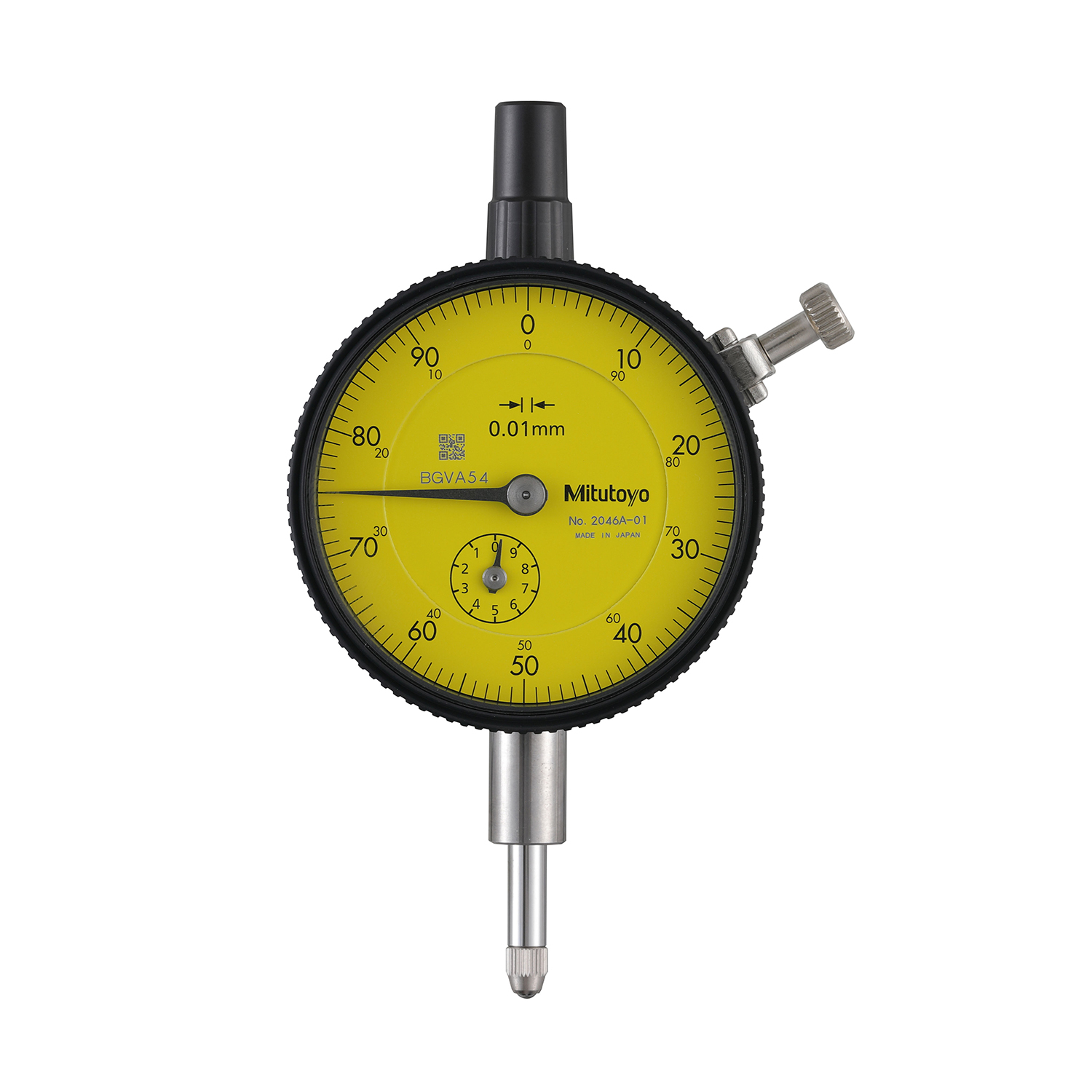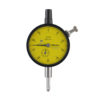| SKU | Item Type | Range / Range/Revolution | Accuracy (1st 2.5 rev. / Overall) | graduation | dial-reading:Dial Reading | force | model-type:Type | Price | Buy | hf:att:pa_item-type |
|---|---|---|---|---|---|---|---|---|---|---|
| 2046A-01 | Metric | 10mm/1mm | 0.01mm/0.01mm | 0.01mm | 1.4N or less | $99.90 | metric | |||
| 2046A-11 | Metric | 10mm/1mm | 0.01mm/0.013mm | 0.01mm | 1.4N or less | $113.40 | metric | |||
| 2046SB-01 | Metric | 10mm/1mm | 0.01mm/0.013mm | 0.01mm | 1.4N or less | $91.80 | metric | |||
| 2046AB-11 | Metric | 10mm/1mm | 0.01mm/0.013mm | 0.01mm | 1.4N or less | $113.40 | metric | |||
| 2047A-01 | Metric | 10mm/1mm | 0.01mm/0.013mm | 0.01mm | 1.4N or less | $99.90 | metric | |||
| 2047A-11 | Metric | 10mm/1mm | 0.01mm/0.013mm | 0.01mm | 1.4N or less | $113.40 | metric | |||
| 2047AB-01 | Metric | 10mm/1mm | 0.01mm/0.013mm | 0.01mm | 1.4N or less | $99.90 | metric | |||
| 2047AB-11 | Metric | 10mm/1mm | 0.01mm/0.013mm | 0.01mm | 1.4N or less | $113.40 | metric | |||
| 2050A-01 | Metric | 20mm/1mm | 0.01mm/0.02mm | 0.01mm | 2.0N or less | $139.50 | metric | |||
| 2050AB-01 | Metric | 20mm/1mm | 0.01mm/0.02mm | 0.01mm | 2.0N or less | $139.50 | metric | |||
| 2056SB-01 | Metric | 25mm/1mm | 0.01mm/0.025mm | 0.01mm | 2.5N or less | $117.00 | metric | |||
| 2109S-11 | Metric | 1mm/0.2mm | 0.003mm/0.004mm | 0.001mm | 1.5N or less | $205.20 | metric | |||
| 2109SB-11 | Metric | 1mm/0.2mm | 0.003mm/0.004mm | 0.001mm | 1.5N or less | $205.20 | metric | |||
| 2119A-11 | Metric | 5mm/0.2mm | 0.007mm/0.01mm | 0.001mm | 1.5N or less | $208.80 | metric | |||
| 2230SB-01 | Metric | 2.5mm/1mm | 0.01mm/0.01mm | 0.01mm | 2.5N or less | $121.50 | metric | |||
| 2231S-01 | Metric | 2.5mm/1mm | 0.01mm/0.01mm | 0.01mm | 1.5N or less | $121.50 | metric | |||
| 2231AB-01 | Metric | 2.5mm/1mm | 0.01mm/0.01mm | 0.01mm | 1.5N or less | $121.50 | metric | |||
| 2902A-01 | Metric | 10mm/1mm | 0.01mm/0.013mm | 0.01mm | 1.4N or less | $114.30 | metric | |||
| 2902AB-01 | Metric | 10mm/1mm | 0.01mm/0.013mm | 0.01mm | 1.4N or less | $114.30 | metric |
Features
Stem dia. 3/8″, #4-48 UNF Thread Yellow Dial Face
Metric Dial Indicator
Dial indicators are precision measuring instruments used in various industries and applications for precise measurements and quality control purposes. They are highly versatile and offer reliable and accurate readings for dimensional measurements. This comprehensive product description aims to provide a detailed overview of dial indicators, their features, applications, and benefits, helping users make informed decisions when selecting the appropriate dial indicator for their specific needs.
A dial indicator, also known as a dial gauge or plunger dial, is a precision measuring instrument used to measure small linear distances, displacements, and deviations. It consists of several key components that work together to provide accurate measurements.
Housing: The dial indicator is housed in a sturdy casing that encloses and protects the internal components. The housing is typically made of metal or plastic, ensuring durability and stability during measurements.
Plunger: The plunger is a spring-loaded rod that extends and retracts based on the measurements being taken. It is designed to move smoothly and provide consistent readings. The plunger can be pressed against a surface or object to measure deviations or displacements.
Rack and Pinion Mechanism: The plunger is connected to a rack and pinion mechanism that converts the linear motion of the plunger into rotary motion. As the plunger moves, it rotates the dial face and needle, indicating the measurement on the calibrated scale.
Dial Face: The dial face is a circular disc that displays the measurements. It is typically marked with a scale calibrated with evenly spaced markings. The dial face is designed for easy readability and precise interpretation of measurements.
Needle or Pointer: The needle or pointer is attached to the rack and pinion mechanism and moves along the dial face as the plunger is extended or retracted. The needle points to the specific measurement on the scale, providing a visual indication of the measured value.
Mounting Options: Dial indicators come with various mounting options, such as lug back, stem, or dovetail mounts. These options allow users to attach the dial indicator to different types of fixtures, machines, or stands, providing flexibility and convenience during measurements.
Dial indicators offer a range of features and specifications to meet different measurement requirements. These include:
Measurement Range: Dial indicators are available in various measurement ranges to accommodate different applications. The range indicates the maximum distance the plunger can move to measure deviations or displacements accurately.
Resolution: The resolution of a dial indicator refers to the smallest increment it can measure. It determines the level of precision and accuracy of the measurements. Dial indicators can have resolutions as fine as 0.001mm or 0.0001 inches, allowing for precise and detailed readings.
Accuracy and Repeatability: Dial indicators are known for their high accuracy and repeatability, ensuring consistent and reliable measurements. They are designed to provide precise readings within specified tolerances, making them suitable for quality control and inspection tasks.
Additional Features: Some dial indicators offer additional features, such as a bezel lock to secure the dial face in a fixed position, a rotating dial for easy zero adjustments, or a shockproof design to withstand harsh working conditions.
Section 1: Overview of Dial Indicators
1.1 Definition:
A dial indicator, also known as a dial gauge or plunger dial, is a mechanical device used to measure small linear distances, displacements, and deviations. It consists of a needle or pointer mounted on a spring-loaded plunger that moves along a calibrated scale, displaying measurements in units such as inches or millimeters.
1.2 Components:
Dial indicators typically comprise a housing, plunger, rack and pinion mechanism, dial face, needle or pointer, and a mounting system. The housing encloses the internal components and provides stability. The plunger extends and retracts based on the measurements being taken. The rack and pinion mechanism translates the linear motion of the plunger into rotary motion of the dial face and needle, enabling accurate readings.
1.3 Measurement Range and Resolution:
Dial indicators offer a wide range of measurement capabilities, with variations available for different measurement ranges. The resolution, or smallest increment, of measurement varies depending on the specific dial indicator model, with some providing resolution as fine as 0.001mm or 0.0001 inches.
Section 2: Features and Specifications
2.1 Dial Face and Scale:
Dial indicators feature a circular dial face with a printed scale, which displays the measurement readings. The scale is calibrated with evenly spaced markings, allowing users to interpret precise measurements quickly and accurately.
2.2 Mounting Options:
Dial indicators come with various mounting options, such as lug back, stem, or dovetail mounts, enabling users to attach the indicator to different types of fixtures, machines, or stands for convenient measurement.
2.3 Dial Configurations:
Dial indicators offer different dial configurations, including single-needle, double-needle, or digital readout displays. Single-needle indicators display measurements directly on the dial face, while double-needle indicators allow for comparative measurements. Digital readout indicators provide precise numeric measurements for enhanced readability.
2.4 Accuracy and Repeatability:
Dial indicators are known for their high accuracy and repeatability. They are designed to provide reliable and consistent measurements, making them indispensable for quality control processes, machining operations, and precise alignment tasks.
Section 3: Applications
Dial indicators find extensive use in numerous industries and applications, including but not limited to:
3.1 Manufacturing and Machining:
Measurement of part dimensions during machining processes
Verification of part flatness, concentricity, and perpendicularity
Alignment of machine tool components
Checking runout and position of rotating machinery parts
3.2 Quality Control and Inspection:
Measurement of tolerances and deviations
Verification of part compliance with specifications
Assessment of part wear and dimensional changes over time
3.3 Engineering and Construction:
Alignment of large structures, such as bridges and buildings
Measurement of deflection and deformation in structural components
Verification of alignment and position of critical machinery
3.4 Automotive and Aerospace:
Measurement of engine components and valve clearances
Verification of part positioning and alignment in aircraft assembly
Inspection of critical dimensions in automotive manufacturing
Section 4: Benefits and Advantages
4.1 Precision and Accuracy:
Dial indicators offer precise and accurate measurements, allowing users to achieve tight tolerances and ensure the quality and precision of their work.
4.2 Versatility:
Dial indicators can be used in a wide range of applications and industries, making them a versatile tool for professionals in manufacturing, engineering, construction, and more.
4.3 Ease of Use:
With their intuitive design and clear dial face, dial indicators are easy to read and operate, even for individuals with limited technical expertise.
4.4 Durability and Longevity:
Built with robust materials, dial indicators are designed to withstand rigorous working conditions, providing long-lasting performance and durability.
4.5 Cost-Effective:
Dial indicators offer an excellent cost-to-performance ratio, delivering accurate measurements at a reasonable price point, making them a cost-effective choice for professionals and businesses.
Dial indicators are versatile measuring instruments used in various industries and applications for precise dimensional measurements. Here are some common uses of dial indicators:
- Manufacturing and Machining: In manufacturing processes, dial indicators are used for several purposes, including:
- Measuring part dimensions during machining operations to ensure accuracy and adherence to specifications.
- Verifying part flatness, concentricity, and perpendicularity.
- Aligning machine tool components for optimal performance.
- Checking runout and position of rotating machinery parts.
- Quality Control and Inspection: Dial indicators play a crucial role in quality control and inspection procedures, including:
- Measuring tolerances and deviations to ensure parts meet required specifications.
- Verifying part compliance with dimensional requirements.
- Assessing part wear and dimensional changes over time.
- Conducting comparative measurements to determine variations between parts.
- Alignment and Positioning: Dial indicators are widely used for precise alignment and positioning tasks, such as:
- Aligning large structures, such as bridges and buildings, to ensure proper construction and stability.
- Measuring deflection and deformation in structural components.
- Verifying alignment and position of critical machinery components for optimal functioning.
- Automotive and Aerospace: Dial indicators find specific applications in the automotive and aerospace industries, including:
- Measuring engine components and valve clearances to ensure optimal performance.
- Verifying part positioning and alignment during aircraft assembly to meet safety standards.
- Inspecting critical dimensions in automotive manufacturing, such as brake rotor runout.
- Maintenance and Repairs: Dial indicators are utilized for maintenance and repair tasks, such as:
- Checking and aligning pulleys, gears, and belts in machinery.
- Verifying the alignment of components in industrial equipment.
- Measuring runout and alignment of rotating shafts.
- Research and Development: In research and development environments, dial indicators are employed for various purposes, including:
- Conducting precise measurements for experimental setups and prototypes.
- Verifying and analyzing dimensional changes in materials and components.
- Assisting in the development and optimization of new products.
These are just a few examples of the broad range of applications for dial indicators. Their accuracy, reliability, and versatility make them essential tools in industries where precise measurements are required for quality control, alignment, and dimensional analysis.
Dial indicators are essential precision measuring instruments widely used in diverse industries and applications. Their accurate measurements, versatility, and ease of use make them invaluable tools for quality control, inspection, machining, and alignment tasks. With a variety of features and options available, users can select the most suitable dial indicator based on their specific requirements. Whether it’s in manufacturing, engineering, or construction, dial indicators provide the reliability and accuracy needed for precise dimensional measurements.





Reviews
There are no reviews yet.